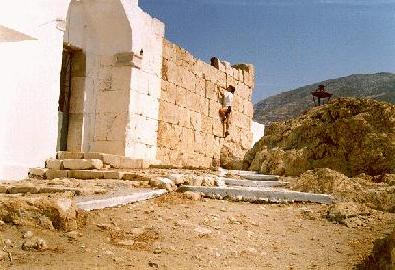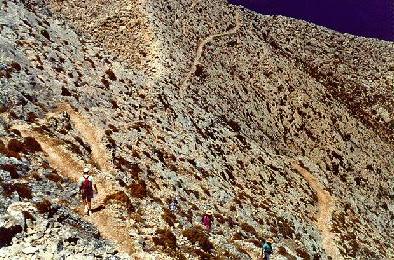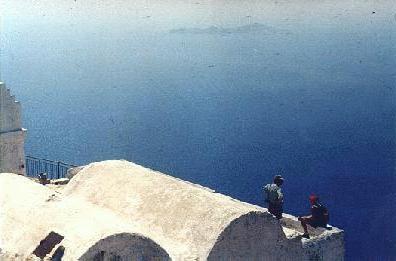
There has only been one book ever written, exlusively about this one-vilage island:"Ueber Anaphi und Anaphaeische Inschriften" by Ludwig Ross, who walked the islands' ancient paths in 1836. Ever since, very little has changed on the island! A rare phenomenon in a fast changing world!
In modern bibliography, Gunter Spitzing in his book "Richtig Wandern Kykladen", has one picture, one map sketch and walking directions to the island's old routes.
Anaphi boasts the Kalamiotisa Monastery, which was built in the middle of the 18th century, on the ruins of the ancient temple of the Greek God Apollon Aegletes. Ancient inscriptions are built every where in the monastery's walls. The neighbouring, to Apollo's sanctuary, ancient temples
dedicated to Aphrodite, Aesculapius and Apollo Astealtes, and an altar of the Zeus Ktesios, have been demolished. Ionic capitals and columns lay all over around, and what remains of the cluster of temples has been converted into warehouses, a chapel and cattle shelters.
A sacrilege?

A sacrilrge again? Just a nice wall appealing to a climer? Whatever it looks like to you, climing the ancient wall was for me (and for any visitor) the only way to sneak into this locked and largely ignored open-air museeum, of unbelievable treasures.
Mount Kalamos, at Anaphi's extreme east, is reputed to be Europe's largest monolith. It rises abruptly to sharply 459 meters above sea level, and its twin peaks, which are often crowned by a nimbus, nestle the medieval castle of the Gattilusi, and the island's oldest monastery. The last monks, who found refuge in these inhospitable heights, intimidated by the pirates, abandoned the monastery when, in the middle of the 18th century, a lightning brought a major desaster. The survivors built a fortified monastery, the Kalamiotissa.

(Above: Walking on the not so precipitous side of Kalamos)

A favorite ritual for hikers today is to ascent to the old monastery, spend the night there, and watch the sunrise. The fact that Apollo, the ancient God of Light, was worshiped here, is no coincidence at all.
Those who want to conquer Anaphi's highest peak, should head to Mount Vigla (560m), a two hours' walk north of Anaphi's only village.
Archeology buffs, who want to see more of Anaphi's invaluable ancient treasures, should walk up the hill of Kastro (320m), where the isle's ancient city was situated. The hill lies halfway between the village and the Kalamiotissa, above the Megalos Roukounas beach, Anaphi's longest (1km) stretch of sand.
Those who want to discover Anaphi's other side, should take the path west of the village, which in two hours will lead them to the lush valley of Vaya. A few families live here, still with no road connections, no electricity.
[Back to my homepage] [Go to "Mountain Sports in Greece" Page] [Back to "Eva's Hikes in Greece" Page]